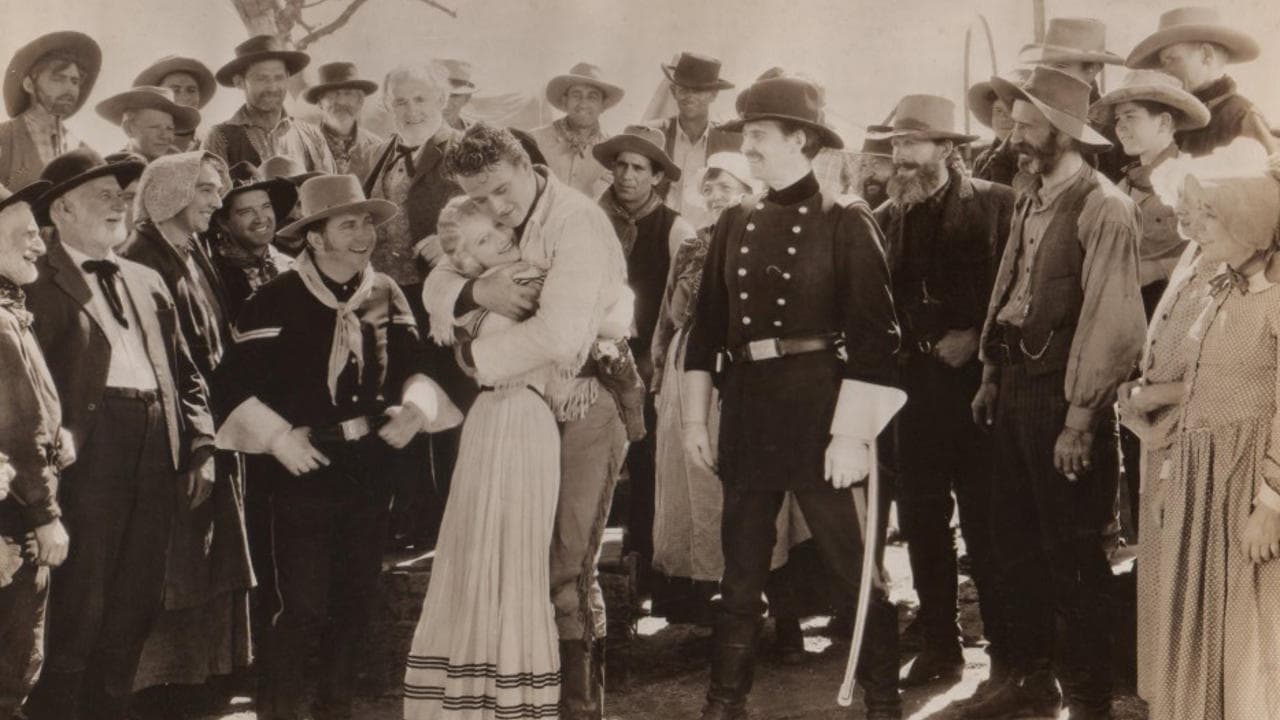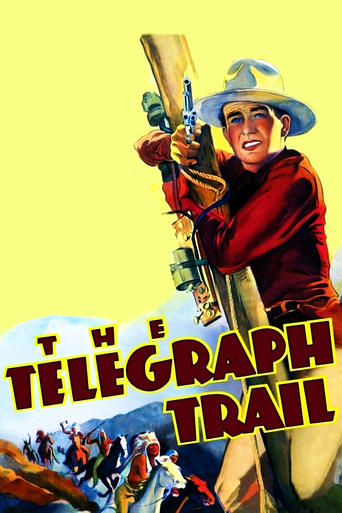

Boring, long, and too preachy.
... View MoreI cannot think of one single thing that I would change about this film. The acting is incomparable, the directing deft, and the writing poignantly brilliant.
... View MoreA film with more than the usual spoiler issues. Talking about it in any detail feels akin to handing you a gift-wrapped present and saying, "I hope you like it -- It's a thriller about a diabolical secret experiment."
... View MoreTrue to its essence, the characters remain on the same line and manage to entertain the viewer, each highlighting their own distinctive qualities or touches.
... View MoreJohn Wayne (John Trent), Marceline Day (Alice Ellis), Frank McHugh (Sergeant Tippy), Otis Harlan (Zeke Keller), Albert J. Smith (Gus Lynch), Yakima Canutt (High Wolf), Lafe McKee (Lafe, old-timer), Clarence Geldert (Cavalry commander), Slim Whitaker, Frank Ellis, and "Duke".Director: TENNY WRIGHT. Screenplay: Kurt Kempler. Suggested by the 1927 scenario The Red Raiders by Marion Jackson. Photography: Ted McCord. Film editor: William Clemens. Music director: Leo F. Forbstein. Western Electric Sound System. Associate producer: Sid Rogell. Producer: Leon Schlesinger.Copyright 25 March 1933 by The Vitagraph Pictures, Inc. A Warner Bros-First National Picture. No New York showcasing. U.S. release: 18 March 1933. U.K. release: 17 April 1933. 59 minutes.SYNOPSIS: For reasons that are never made clear, a white trader stirs up the Indians to attack the telegraph linesmen and construction workers. NOTES: As far as I know, this is the only film directed by Tenny Wright, one-time silent film actor and assistant director who rose to become production manager at Warner Bros where he made important contributions to just about all the famous Warner features of the 30s and 40s. COMMENT: Instead of re-making the 1927 Ken Maynard western, "The Red Raiders", this time producer Schlesinger (of later Merrie Melodies and Looney Tunes fame) decided to have a new story fashioned around the original film's truly spectacular action footage. This was a bad mistake. Not only is the new plot weak, but it's full of holes, inconsistencies and downright stupidities. The whole business with the box — what did they need a big empty box for, in the first place? — is a good example of the writer's haphazard approach. At first it seems the box is fairly solid, but later on it's revealed there's a hole in the side big enough for the girl to put her hand through. The heroine's actions throughout are almost totally unbelievable, but the hero's are only marginally more convincing, mostly because he is called upon to react to, rather than initiate events. His reaction times are stupendously slow. From the very first scene with the telegraph message from Jonesy, it takes a considerable time for the import of the message to sink into his thick skull. It seems to go against the whole canon of "B"-western lore to infer the hero is slow-witted, but this suggestion of brawn with no brains is confirmed in his very first encounter with the heroine in which he displays a similar, singular lack of even basic mental acuity. His immaturity is then further demonstrated by his complete change of attitude towards the girl. No wonder John Wayne constantly looks uncomfortable, hesitant, even confused! The support players are of even less help. McHugh and Harlan are both over-zealous bores whose comic cut-ups provide little genuine amusement. Albert J. Smith does what he can with the heavy but is stymied by a script that provides him with virtually no motivation. Canutt plays the Indian in a totally clichéd manner.Wright's slack, slow direction is compounded by the cutting in of obviously silent-speed material. Along with McCord's deliberately flat photography (to tone in with the copious Red Raiders action directed by Albert Rogell), these technical credits lend the movie the air of a musty if awesomely spectacular museum piece. Wayne's efforts to regain his "A" standing certainly took a backward jolt with this entry.
... View More. . . so Warner Bros. was in an even better position to Warn America about Looming Threats as it released THE TELEGRAPH TRAIL during the Depths of the Great Depression. As "John Trent, Army Scout" John Wayne yet again portrays a Robin Hood-like Socialist, fighting Corrupt Capitalism, as he did in countless flicks up until World War Two, when he used some Big Business Connections to Dodge the Draft, and afterwards Cozied up to the few Actual Capitalist War Heroes, such as Brig. Gen. Jimmy Stewart. (Trying to over-compensate for Turning Yellow, Wayne would go on to send hundreds of Valiant Veterans to the Poorhouse, Prison, or Early Graves while heading several Vigilante Groups during the 1950s.) But as an "innocent" 20-something, Wayne fights against Corrupt Businessman "Gus Lynch" and Lynch's band of Tea Party-style Terrorists. Like Today's Leading Capitalist, Trumplestiltskin, Lynch attacks the Media--in this case, the brand new "Singing Wire" or Intercontinental Telegraph. Instead of saying that his female critics are "bleeding from their Wherevers," as does Trumpenstein, Lynch simply crates them up in his version of Pandora's Box. But Lynch brazenly rides side-by-side with Terrorist Leader "High Wolf," just as the Teflon Don has been seen shamelessly climbing into bed with Vladimir "Mad Dog" Putin of Russia.
... View MoreThis early John Wayne B-movie is apparently not in the public domain--unlike many of his early films. This Leon Schlessinger film has been released by Warner Brothers/Turner Classic Movies instead of the usual cheap public domain videos you see in bargain bins. Unfortunately, however, despite this higher pedigree (and a slightly better quality print), this isn't all it's cracked up to be--there are no DVD extras nor are there any captions. It's a rather unimpressive release for Warner/TCM.Instead of the usual sidekicks (such as the ubiquitous Gabby Hayes), this one features Frank McHugh. While he's a very common actor in Schlessinger (whose studio was soon bought by Warner) and Warner Brothers films of the era, I can only recall a few times where he appeared in westerns. He was more of the comic relief in contemporary period pieces--though he does a very nice job here and looked pretty comfortable on a horse.The film begins with a group of telegraph installers being attacked by American-Indians. These Indiand, however, were orchestrated by a jerk named Lynch--who wanted to keep the telegraph and civilization away in order to force the settlers to deal with only him and his over-priced supplies. Although one of the telegraph men is shot, he's still able to relay a message to the fort many miles away--and Wayne and McHugh come to investigate. The message told what was happening but the man couldn't finish his transmission--and Wayne is trying to discover who the white man is who is stirring up all the Indian trouble. This is a weak point of the film, as it's 100% obvious who is behind it--there's no suspense whatsoever! Later, a lady overhears Lynch's plans to attack another group of telegraph installers. I have no idea why she didn't just tell Wayne. Instead, she devised a ridiculously complicated and sure to fail method to alert Wayne without revealing her identity. Why....?! And, as she was a witness to the conspiracy between Lynch and the Indian (Yakima Canutt), why didn't she just tell everyone so that Lynch would be arrested and...um...lynched! Then, they all could have gone out for pizza and had a party. Instead, the film went on for another 30 minutes---climaxing with a clichéd Indian attack--which is headed off at the last minutes by (surprise of surprises) the US Cavalry! The are absolutely no major surprises in this film. As usual, Wayne is very good and McHugh was a much better than normal sidekick...but even these couldn't overcome bad writing--even by cheap B-movie standards! It is entertaining...but a bit brainless.
... View MoreThis early John Wayne western has the frequently used plot of some baddies convincing indians that the white men are up to no good, in this case by building a telegraph line to connect the east and west. But I still had some fun watching it, mostly because of the comedy by both Frank McHugh and Otis Harlan. In their funniest scene, they get drunk while the indians are attacking and they are bleary-eyed enough to think one bullet fells as many as 8 indians. The scene itself, in the middle of a battle in which many are killed, indicates director Tenny Wright did not direct with a heavy hand; I sensed a light-hearted touch throughout, which was a welcome change from most of these westerns. I also laughed whenever some clichéd event occurred, such as the love interest, Marceline Day, overhearing the the baddies talking about the upcoming ambush and getting the information to Wayne. And Wayne's horse, Duke, enters the fight by kicking indians when he was in a tent and observes their silhouettes against the tent wall. No wonder he was billed second in the opening credits, but I still wondered how the other actors felt about being outbilled by a horse.
... View More